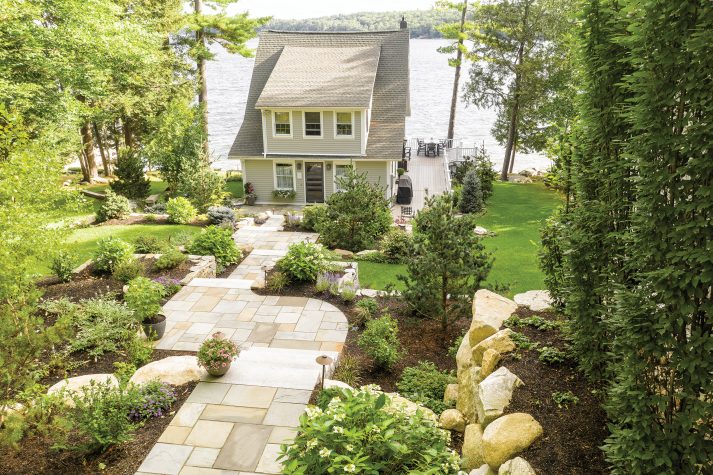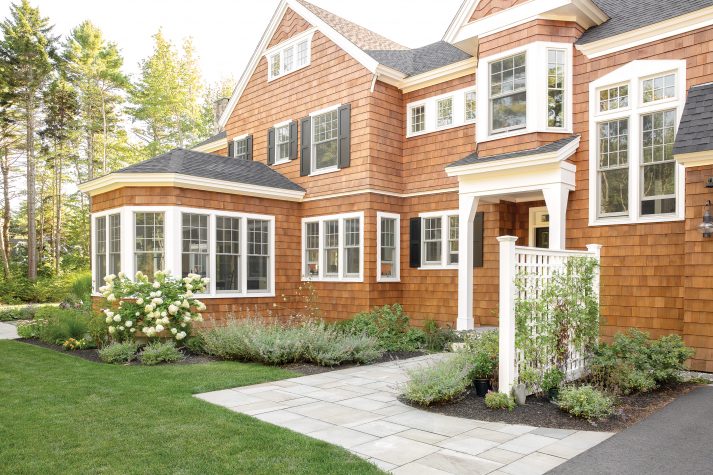Natural Wisdom
Combining spiritual practices with practical know-how, landscape designer Ted Carter lives to grow.
Ted Carter has been planting, growing, and pruning since he was a child. Growing up in suburban Chicago, he found himself drawn to every wild, overgrown space. “I was kind of a loner,” the landscape designer says. “Though I am very social, I didn’t do a lot of play. I was more purpose-driven.” He felt that the “invisible world,” and the natural elements were “like friends.” Instead of games or sports, Carter cleared orchards and stacked bricks. It was an unusual childhood in some ways, but it worked for Carter, and his parents supported his passion. When he was a teenager, his family moved to Maine. His father built him his first greenhouse, and Carter started his very first business. Word spread, and his work spoke for itself. Soon, he was landscaping every McDonald’s in the state and hiring his classmates to plant hostas and trim boxwoods. At the age of 19, he had grossed over $100,000. “And those were in 1974 dollars,” Carter adds.
That was almost half a century ago. Although Carter has owned several different landscaping companies—he sold his first one and moved to Dallas for a time—he’s never stopped getting his hands dirty. Gardening gives him a sense of meaning and joy. As he’s grown older, his style has changed a good deal. He’s learned and evolved, as has the gardening world in general. “Back in the 1970s, landscaping was what you might call pedestrian,” he explains. “It was generic. You had geraniums and rhodondendrons, hostas and lilies.” He remembers Maine gardens being dominated by boxwood hedges. That’s what was available in the shops, so that’s what he worked with. “My palette was much more limited. I didn’t work with bonsais or tropicals or exotics like I do now. People’s tastes have become more sophisticated. They’ve become more diverse in many respects.”
Throughout his life, Carter has cultivated a certain sensitivity to the “invisible world.” There is a strong spiritual element to his work, because the land itself is a spiritual force. He’s always known this on some level, but he began delving deeper into energy work in his 40s. Carter had come to gradually realize that his landscapes were affecting his clients in ways he didn’t expect. “People would say to me, ‘We’re only going to be here a year,’ and then I’d see them in the grocery store years later,” he remembers. “They’d tell me that the landscape changed their appreciation for the house. It made them want to stay.” He began to realize that a good landscape, in a “subliminal and calculated way,” tells people how to move through the world. It tells you where to park your car and where to find the doorbell. It can also tell you to relax, to stop and smell the roses, to focus your mind on the present moment.
To better understand the energies that surround us, Carter turned to shamans. He studied under Lench Archulata, of Arizona, and a mentor, Caroline Myss of Caroline Myss Educational Institute (CMED) in Chicago. “I’m a dowser,” he says. “I carry a dowsing rod in my pocket as I walk, and I gather information from the land.” On every project, he works to get a sense of what the ground is telling him, and what his clients are telling him—both in words and in gestures. He seeks to understand their style and sensibility, what brings them comfort and joy. He takes this information and combines it with his knowledge of nature and the elements to create outdoor spaces that will last. “One of the things I hear a lot is, ‘It looks like it’s been here forever,’” he says. “That’s a sign that we did our job properly. We were mindful, and we were respectful of how things should work.”
He’s also responsible for solving practical, physical problems, like directing drainage or terracing a sloped lawn to make it more accessible. Recently, Carter worked on a house on Sebago Lake that had a huge problem with waterflow, a problem that he answered by creating a series of graduated stone steps and landings. The homeowners’ style was “eclectic and informal,” which freed Carter to play with textures and color. He brought in barren strawberry, hibiscus, and climbing hydrangea. For a more formal client in Kennebunkport, he used a rather different approach, bringing in bluestone, ornamental grasses, and weeping spruce. Each project feels distinct, natural yet sophisticated—miles away from the ’70s gardens full of geraniums and hostas.
Invariably, in the process of building or adding on to a house, the land gets disturbed. “Land, after a construction crew goes in, has been violated and destroyed. It needs to be healed,” Carter says. “If you wanted to boil it down to the spiritual element, that’s it. I work with the sacred feminine to heal the land after construction.” For him, this means paying close attention to his intuition and following his instincts. One thing he’s noticed in the past few years is how important it is to create a sense of congruity with his crew. “We used to have a masonry crew come in, the plant people, the flower people. The eco-field is all confused. It’s like, who are these people?” he says. This can introduce a disconnect into the design.
While some of this sounds quite mystical, there’s a certain common sense in Carter’s practices. It helps if everyone working on a project knows where it’s going. It’s good to observe your clients—not just listening to their words, but looking at their personal presentation and picking up on their nonverbal cues. Land does tell us what it needs. Just think of your half-wilted tomatoes and you’ll know what that means. The world around us is speaking, and as Carter points out, “We’re just visitors here. We have a perception that we own the land, but we don’t. It was here before us. People have come and gone before.” The land, wild or manicured, persists.








